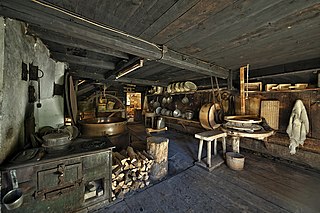
A dairy is a place where milk is stored and where butter, cheese and other dairy products are made, or a place where those products are sold. It may be a room, a building or a larger establishment. In the United States, the word may also describe a dairy farm or the part of a mixed farm dedicated to milk for human consumption, whether from cows, buffaloes, goats, sheep, horses or camels.

Plainsboro Township is a township situated in southern Middlesex County, within the U.S. state of New Jersey. Centrally located in the Raritan Valley region, the township is an outer-ring suburb of New York City in the New York metropolitan area, even though it is slightly geographically closer to Center City, Philadelphia than to Midtown Manhattan. As of the 2020 United States census, the township's population was 24,084, its highest decennial count ever and an increase of 1,085 (+4.7%) from the 22,999 recorded at the 2010 census, which in turn had reflected an increase of 2,784 (+13.8%) from the 20,215 counted at the 2000 census.

Condensed milk is cow's milk from which water has been removed. It is most often found with sugar added, in the form of sweetened condensed milk (SCM), to the extent that the terms "condensed milk" and "sweetened condensed milk" are often used interchangeably today. Sweetened condensed milk is a very thick, sweet product, which when canned can last for years without refrigeration if not opened. The product is used in numerous dessert dishes in many countries.
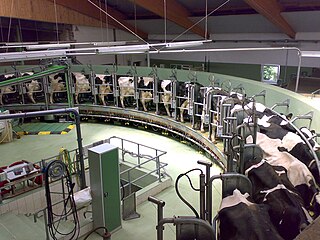
Dairy farming is a class of agriculture for long-term production of milk, which is processed for eventual sale of a dairy product. Dairy farming has a history that goes back to the early Neolithic era, around the seventh millennium BC, in many regions of Europe and Africa. Before the 20th century, milking was done by hand on small farms. Beginning in the early 20th century, milking was done in large scale dairy farms with innovations including rotary parlors, the milking pipeline, and automatic milking systems that were commercially developed in the early 1990s.

Raw milk or unpasteurized milk is milk that has not been pasteurized, a process of heating liquid foods to kill pathogens for safe consumption and extending the shelf life.
The year 1930 in science and technology involved some significant events, listed below.

An udder is an organ formed of two or four breasts on the females of dairy animals and ruminants such as cattle, goats, and sheep. An udder is equivalent to the breast in primates and elephantine pachyderms. The udder is a single mass hanging beneath the animal, consisting of pairs of mammary glands with protruding teats. In cattle and camels, there are normally two pairs, in sheep, goats and deer, there is one pair, and in some animals, there are many pairs. In animals with udders, the mammary glands develop on the milk line near the groin, and mammary glands that develop on the chest are generally referred to as breasts.

Dairy cattle are cattle bred for the ability to produce large quantities of milk, from which dairy products are made. Dairy cattle generally are of the species Bos taurus.
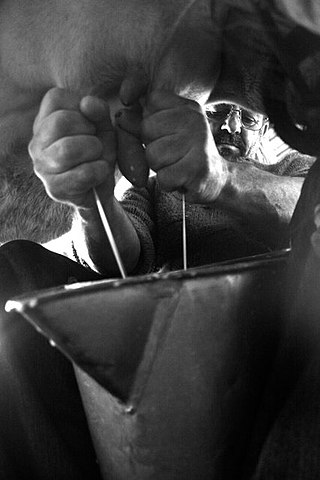
Milking is the act of removing milk from the mammary glands of cattle, water buffalo, humans, goats, sheep, and, more rarely, camels, horses, and donkeys. Milking may be done by hand or by machine, and requires the animal to be currently or recently pregnant. The milker may refer either to the animal that produces the milk or the person who milks said animal.

Braum's is an American chain of ice cream parlor and fast food restaurants. Based in Oklahoma City, Braum's was founded in 1968 by William Henry "Bill" Braum in Oklahoma City. The company operates over 300 restaurants in 5 states, primarily in the Southern United States, namely the West South Central states of Oklahoma and Texas.

Automatic milking is the milking of dairy animals, especially of dairy cattle, without human labour. Automatic milking systems (AMS), also called voluntary milking systems (VMS), were developed in the late 20th century. They have been commercially available since the early 1990s. The core of such systems that allows complete automation of the milking process is a type of agricultural robot. Automated milking is therefore also called robotic milking. Common systems rely on the use of computers and special herd management software. They can also be used to monitor the health status of cows.
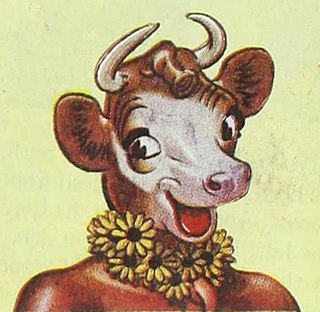
Elsie the Cow is a cartoon cow developed as a mascot for the Borden Dairy Company in 1936 to symbolize the "perfect dairy product". Since the demise of Borden in the mid-1990s, the character has continued to be used in the same capacity for the company's partial successors, Eagle Family Foods and Borden Dairy.
Henry Williams Jeffers was an American dairyman and Republican Party politician who served as chairman of the New Jersey Republican State Committee.
The Bender Machine Works in Hayward, Wisconsin, is a dairy equipment manufacturer that played a major role in the history of the dairy farming business in the United States from the 1950s to the 1980s, producing milk pipeline and milk transfer cart components, and washing/vacuum-releasing equipment.
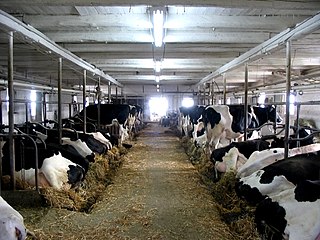
Dairy farming is one of the largest agricultural sectors in Canada. Dairy has a significant presence in all of the provinces and is one of the top two agricultural commodities in seven out of ten provinces.
City Dairy Company Limited was a dairy company founded by Walter Edward Massey, president of Massey-Harris, to deliver milk in the city of Toronto. The company was the first Canadian dairy to supply pasteurized milk.

Stuart Joseph Patton was an American dairy scientist known for his research in the fields of milk chemistry and the biological processes that regulate milk synthesis in the mammary gland. He was professor of dairy science/food science at Pennsylvania State University from 1949 to 1980 and adjunct professor in the Department of Neurosciences, School of Medicine, University of California, San Diego, and in the School of Family Studies and Consumer Sciences at San Diego State University until his retirement in 2001.

The Dairy Campus in the Netherlands is a test farm and centre for scientific research and practical training in the field of dairy farming, located, the capital of the province of Friesland. The decision to launch this centre was made in 2011, and it was opened in 2016. The Campus traces its roots to the test farm Bosma Zathe, founded in Ureterp in 1944; its building complex was formerly called Nij Bosma Zathe. Today, the Dairy Campus is part of Wageningen University & Research (WUR). All activities in the centre are focused on the development of sustainable methods for the production and processing of dairy products.

Dairy is a major industry in the state of Wisconsin. Being known for its dairy production, the state is often called "America's Dairyland." The industry is prominent in official state symbols—being displayed on the state's license plates, state's slogan, and on the state quarter.















